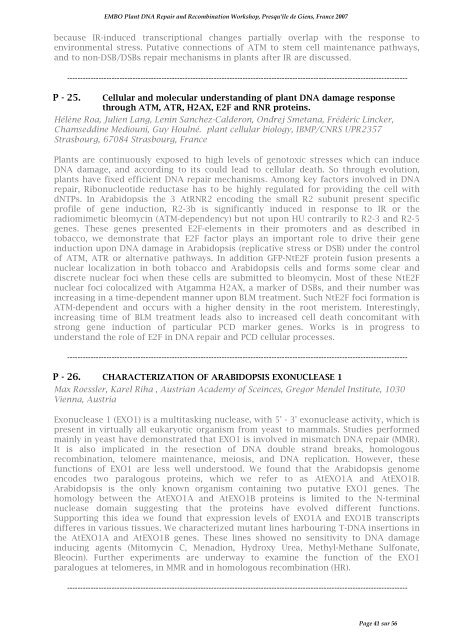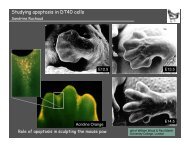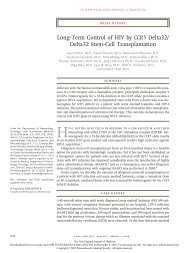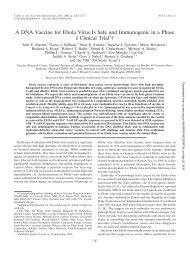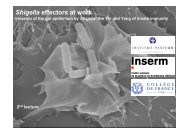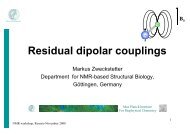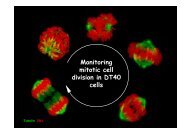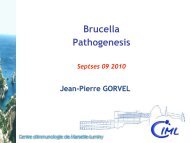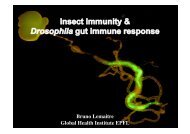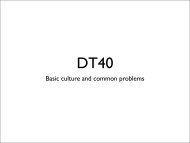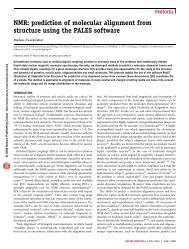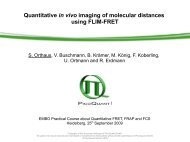pdf file - Events - EMBO
pdf file - Events - EMBO
pdf file - Events - EMBO
You also want an ePaper? Increase the reach of your titles
YUMPU automatically turns print PDFs into web optimized ePapers that Google loves.
<strong>EMBO</strong> Plant DNA Repair and Recombination Workshop, Presqu'île de Giens, France 2007<br />
because IR-induced transcriptional changes partially overlap with the response to<br />
environmental stress. Putative connections of ATM to stem cell maintenance pathways,<br />
and to non-DSB/DSBs repair mechanisms in plants after IR are discussed.<br />
----------------------------------------------------------------------------------------------------------------------------------<br />
P - 25. Cellular and molecular understanding of plant DNA damage response<br />
through ATM, ATR, H2AX, E2F and RNR proteins.<br />
Hélène Roa, Julien Lang, Lenin Sanchez-Calderon, Ondrej Smetana, Frédéric Lincker,<br />
Chamseddine Mediouni, Guy Houlné. plant cellular biology, IBMP/CNRS UPR2357<br />
Strasbourg, 67084 Strasbourg, France<br />
Plants are continuously exposed to high levels of genotoxic stresses which can induce<br />
DNA damage, and according to its could lead to cellular death. So through evolution,<br />
plants have fixed efficient DNA repair mechanisms. Among key factors involved in DNA<br />
repair, Ribonucleotide reductase has to be highly regulated for providing the cell with<br />
dNTPs. In Arabidopsis the 3 AtRNR2 encoding the small R2 subunit present specific<br />
pro<strong>file</strong> of gene induction, R2-3b is significantly induced in response to IR or the<br />
radiomimetic bleomycin (ATM-dependency) but not upon HU contrarily to R2-3 and R2-5<br />
genes. These genes presented E2F-elements in their promoters and as described in<br />
tobacco, we demonstrate that E2F factor plays an important role to drive their gene<br />
induction upon DNA damage in Arabidopsis (replicative stress or DSB) under the control<br />
of ATM, ATR or alternative pathways. In addition GFP-NtE2F protein fusion presents a<br />
nuclear localization in both tobacco and Arabidopsis cells and forms some clear and<br />
discrete nuclear foci when these cells are submitted to bleomycin. Most of these NtE2F<br />
nuclear foci colocalized with Atgamma H2AX, a marker of DSBs, and their number was<br />
increasing in a time-dependent manner upon BLM treatment. Such NtE2F foci formation is<br />
ATM-dependent and occurs with a higher density in the root meristem. Interestingly,<br />
increasing time of BLM treatment leads also to increased cell death concomitant with<br />
strong gene induction of particular PCD marker genes. Works is in progress to<br />
understand the role of E2F in DNA repair and PCD cellular processes.<br />
----------------------------------------------------------------------------------------------------------------------------------<br />
P - 26. CHARACTERIZATION OF ARABIDOPSIS EXONUCLEASE 1<br />
Max Roessler, Karel Riha , Austrian Academy of Sceinces, Gregor Mendel Institute, 1030<br />
Vienna, Austria<br />
Exonuclease 1 (EXO1) is a multitasking nuclease, with 5' - 3' exonuclease activity, which is<br />
present in virtually all eukaryotic organism from yeast to mammals. Studies performed<br />
mainly in yeast have demonstrated that EXO1 is involved in mismatch DNA repair (MMR).<br />
It is also implicated in the resection of DNA double strand breaks, homologous<br />
recombination, telomere maintenance, meiosis, and DNA replication. However, these<br />
functions of EXO1 are less well understood. We found that the Arabidopsis genome<br />
encodes two paralogous proteins, which we refer to as AtEXO1A and AtEXO1B.<br />
Arabidopsis is the only known organism containing two putative EXO1 genes. The<br />
homology between the AtEXO1A and AtEXO1B proteins is limited to the N-terminal<br />
nuclease domain suggesting that the proteins have evolved different functions.<br />
Supporting this idea we found that expression levels of EXO1A and EXO1B transcripts<br />
differes in various tissues. We characterized mutant lines harbouring T-DNA insertions in<br />
the AtEXO1A and AtEXO1B genes. These lines showed no sensitivity to DNA damage<br />
inducing agents (Mitomycin C, Menadion, Hydroxy Urea, Methyl-Methane Sulfonate,<br />
Bleocin). Further experiments are underway to examine the function of the EXO1<br />
paralogues at telomeres, in MMR and in homologous recombination (HR).<br />
----------------------------------------------------------------------------------------------------------------------------------<br />
Page 41 sur 56


